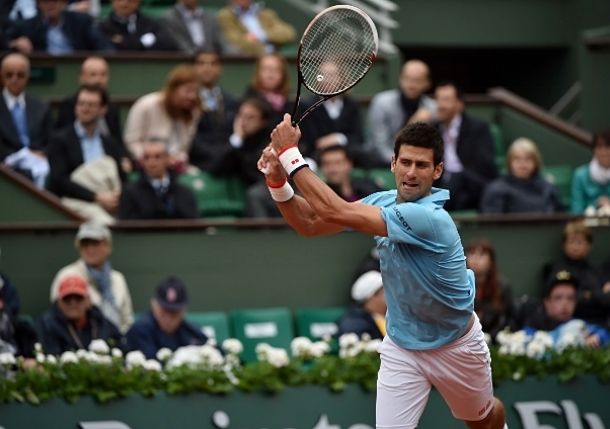
By Chris Oddo | @TheFanChild | Monday September 21, 2020
Paris will bring a new reality to tennis fans in 2020 as Roland Garros in September will likely feature conditions that we haven’t seen at tennis’ annual clay-court Grand Slam before: Shorter days, more humidity, a higher overall chance for rain and, of course, a new roof to keep the rain out of Court Philippe Chatrier, which will complicate matters even further.

So what will it mean for today’s top players?
Already there has been talk that Rafael Nadal might be a little less enthusiastic than usual about the conditions in Paris in 2020—this is, after all, a man who was born to administer beatdowns beneath balmy Paris sun strokes every spring.
“Conditions will be different,” Novak Djokovic said after claiming the Rome title on Monday. “I think today I experienced something [in the final] that might be the case in terms of conditions in Paris. Little bit of rain, wet court, clay, not much of a bounce, a bit cold. That’s what I think people have been talking about from a Paris weather standpoint.”
Nadal doesn’t typically play on clay in September, and he got a taste of the slow conditions that he might expect in Paris when he fell to Diego Schwartzman in the quarterfinals at Rome.
“It has been a super heavy evening in terms of humidity, conditions out there were much heavier than the previous days in terms of the bounces of the ball, for me it was difficult to push him back,” he said.
Nadal can find many ways to win on a clay court, but when he’s not benefitting from the high bounce that his topspin drives can generate, one of his key weapons is not as effective. Conditions matter to Nadal, and they matter to everyone else who is handed the task of facing him.
Nadal will be the favorite in Paris even if the forecast calls for a two-week monsoon, but nevertheless, hope seems to be growing among his fiercest competitors that the conditions will—for once—help them and not him.
“It’s Nadal, even though he lost this week, a lot of people will agree that he’s the No.1 favorite,” Djokovic said in Rome on Monday. “The record that he has there, the history of his results, you just can’t put anybody in front of him.”
Djokovic has repeated those lines verbatim for many years, but his next few sentences told a different story about what he really felt about his chances in Paris.
“Diego showed that Nadal is beatable on clay, the conditions that they played on, obviously heavy clay, not much bounce, humid, night session, we are going to have that as well in Paris,” he said. “Night session, under the lights, as I said a little bit less bounce. I don’t know... I’m pretty sure that he does not prefer that to a high bounce. I know he likes the high bounce, he likes the hot and warm and fast conditions where he can use his spin a lot.”
Does Djokovic feel even more sanguine about his chances than he is leading us to believe? And will the other players in the draw have more will if they’re drawn to face Nadal in the early rounds, based on the conditions they think they might be playing in?
Keep in mind, we don’t know how the courts will actually play in Paris this year. We just know what we think we know. The rest will have to take place on the courts, the very courts that Nadal has been virtually unbeatable on every single year. He's 93-2 at the tournament, so we shouldn't forget that.
But every parade has the potential to be rained on, and even more so in the fall. The current weather forecast shows temperatures topping out in the high 60’s for the first week, with plenty of sprinkles mixed in.
"The forecast that I'm looking at right now on my phone looks like it's going to be fairly cool as far as top end temperatures," two-time champion Roland-Garros champion Jim Courier told Tennis Now during a conference call to promote Tennis Channel's coverage of the French Open on Monday. "Normally in the spring event, we get a few really hot days. Doesn't look likely for us to have that. Playing into the evening could be quite cool. What does that mean? That means the ball won't be lively. A lot of the players that like to adjust their string tension lower to get more power will probably do that to get a bit more movement on the ball.
"Particularly as it revolves around Rafa, it means his forehand probably won't jump up as high as he would like it to. Won't be jumping out of the typical strike zone of the backhands. That's been such a dominant weapon for him in the past. We've seen him be vulnerable against a player like Diego Schwartzman in recent years under heavy, cooler conditions than hot, drier conditions. That will be something for him to look at."
Beating Nadal, even on a muddy track rife with puddles, is no small task. There may be hope but you need it in busloads if you are going to stand toe-to-toe with the king of clay.
Djokovic, for one, seems eager for the challenge.
“Let’s see,” said Djokovic. “It’s going to be interesting. Even though he’s the No.1 favorite there are players that can win against him there, it’s obviously best-of-five, so you have to be really fit to be able to achieve that.”